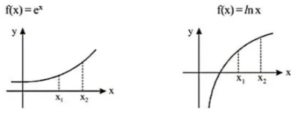
One of the key concepts in the derivative application is monotonicity. The monotonicity of a function provides information about the function’s behaviour. A function is said to be monotonically increasing if its graph only grows with increasing equation values. Similarly, if the values of a function are only decreasing, it is monotonically decreasing. The sign of a function’s derivative determines its nature.
A monotonic function is one in which the graph of a function is in either the upward or downward direction. If the function’s graph is pointing upward, it has increasing values and is said to be monotonically increasing. Similarly, if the graph of a function is pointing down, it has decreasing values and is said to be monotonically decreasing.
Extremum is pointed in a function’s domain where the graph changes direction from upwards to downwards or downwards to upwards. The derivative of a function, if it exists at such points, is always zero.
If a function increases or decreases across its entire domain, it is said to be monotonic.
If x1 < x2and F(x1) < F(x2) the function is known as an increasing function or a strictly increasing function.
For F(x) = e(-x)
If x1 > x2 and F(x1) > F(x2), then the function is known as a decreasing function or a strictly decreasing function.

(a). For a monotonically increasing function y = f(x), dy/dx ≥ 0 for all such values of interval (a,b), and equality may hold for discrete values.
(b). For a monotonically decreasing function y = f(x), dy/dx ≤ 0 for all such values of interval (a,b), and equality may hold for discrete values.

The point on the curve where the function value is greater than the limiting function value is defined as the local maxima.
The point on the curve where the function value is less than the limiting function value is defined as the local minima.
The extremum of a function is the function’s smallest and greatest value. There are three distinct cases for all such values, which are as follows:
A monotonic function is one that is either entirely nonincreasing or entirely nondecreasing. A function is monotonic if the sign of its first derivative (which does not have to be continuous) does not change.
The following are the results of the monotonic function test: Assume that a function is continuous on [a, b] and differentiable on (a, b). If the derivative for all x in (a, b) is greater than zero, the function is increasing on [a, b]. If the derivative for all x in (a, b) is less than zero, the function is decreasing on [a, b].